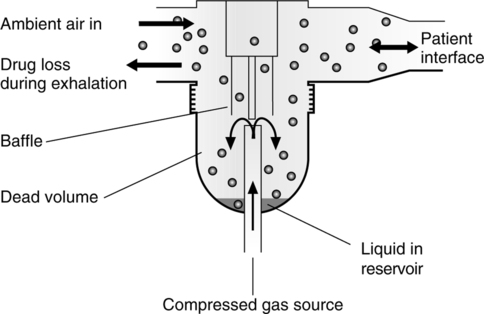Aerosol and Humidity Therapy
I Stability: Stability is the tendency of aerosol particles to remain in suspension. The following factors affect the stability of an aerosol.
A Size: The smaller the aerosol particle, the greater the tendency toward stability. The larger the particle, the greater its tendency to rain out of suspension.
B Concentration: The greater the concentration of particles, the greater the tendency for individual particles to coalesce into larger particles and rain out of suspension.
C Humidity: The greater the relative humidity of the gas carrying the aerosol, the greater the stability of the aerosol.
II Penetration and Deposition of an Aerosol in the Respiratory Tract
A Penetration refers to the depth within the respiratory tract that an aerosol reaches.
B Deposition is the rain-out of aerosol particles within the respiratory tract.
C Depth of penetration and volume of deposition depend on
1. Gravity: Gravity decreases penetration and increases premature deposition but has minimal effect on aerosol particles in the therapeutic range of 1 to 5 μm (Table 35-1).
TABLE 35-1
Penetration and Deposition Versus Particle Size
| Particle Size (μ m) | Deposition in Respiratory Tract |
| >100 | Do not enter respiratory tract |
| 100-10 | Trapped in mouth |
| 100-5 | Trapped in nose |
| 5-2 | Deposited proximal to alveoli |
| 2-1 | Can enter alveoli, 95-100% of particles 1 mu;m in size settling |
| <1-0.25 | Stable, with minimal settling |
2. Kinetic energy: The greater the kinetic energy of the gas carrying the particles, the greater the tendency for premature deposition. This is because coalescence and impaction are increased.
3. Inertial impaction: Deposition of particles is increased at any point of directional change or increased airway resistance. Thus the smaller the airway diameter, the greater the tendency for deposition.
III Ventilatory Pattern for Optimal Penetration and Deposition
A The patient’s ventilatory pattern is the most important variable that can be controlled to ensure maximum penetration and deposition of aerosol particles during aerosol treatments.
1. Large, slowly inspired tidal volume (Vt) over 3 to 4 seconds except with dry powder aerosols. Dry powder aerosols require a fast inspiratory flow rate.
2. After inhalation a 3- to 4-second breath-holding period is advisable to ensure maximum deposition.
3. With large-volume aerosols (ultrasonic nebulizers) a face mask should be used.
4. Exhalation should be relaxed and normal.
5. Coughing should be encouraged if secretion mobilization occurs and at the completion of treatment.
C Attempts should be made to have all patients receiving aerosol therapy assume the described ventilatory pattern.
Inhaled particles are removed from the respiratory tract by three mechanisms.
A Primary mechanism: Mucociliary escalator, which moves approximately 100 ml of secretions to the oropharynx per day.
V Indications for Aerosol Therapy
A Bland aerosol administration is the delivery of aerosolized sterile water and isotonic or hypertonic saline.
1. Indications (Modified from AARC Clinical Practice Guideline: Bland aerosol administration, 2003)
a. Presence of upper airway edema
e. Postoperative management of the upper airway
b. Bronchoconstriction when artificial airway is used
(1) May be a problem primarily with neonates and infants
(2) Associated more frequently with the use of ultrasonic nebulizers than with the use of jet nebulizers
g. Edema is associated with decreased compliance and gas exchange and with increased airway resistance
B Indications for medicated aerosol administration are the need to deliver bronchodilators, antibiotics, or other pharmacologic agents in aerosol form to the lung parenchyma.
VI General Goals of Aerosol Therapy
1. Improve efficiency of cough mechanism
2. Restore and maintain normal function of mucociliary escalator
B Humidify gases delivered to patients with artificial airways (large volume nebulizer; Figure 35-1). Aerosol delivered to patients with artificial airways should be heated.

C Deliver medications by small volume nebulizer (SVN), metered dose inhaler (MDI), or dry powder inhaler (DPI)
VII Jet Aerosol Generators (Gas Powered)
A These generators use jet mixing to produce an aerosol and entrain a second gas.
B A system of baffles is used to impact large particles out of suspension.
C These generators are commonly used for delivery of medications (SVNs) and for humidification of inspired gases (large volume nebulizers).
VIII Aerosol Generators to Deliver Medications
A Small volume (jet) nebulizer (Figure 35-2)
1. Does not require patient coordination
2. A mouthpiece or face mask may be used.
3. Able to deliver high doses of medication
4. The amount of drug nebulized increases as the fill volume increases. A fill volume of 4 ml is recommended.
5. Generally the higher the flow to the nebulizer, the smaller the particle size generated; 6 to 8 L/min is recommended.
6. May be powered by oxygen or compressed air
7. SVNs are inconvenient to use outside the hospital environment and not portable.
8. Bacterial contamination of the SVN is common.
9. SVNs are usually used to administer aerosolized medications to infants and young children or to administer medications not available in MDIs.
10. SVNs may be used to deliver aerosolized medications during mechanical ventilation.
a. Proper technique for aerosol delivery by SVN during mechanical ventilation








